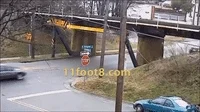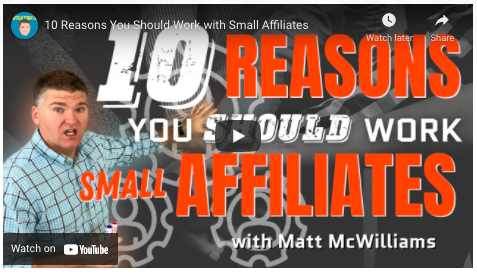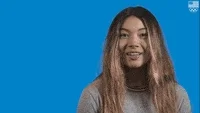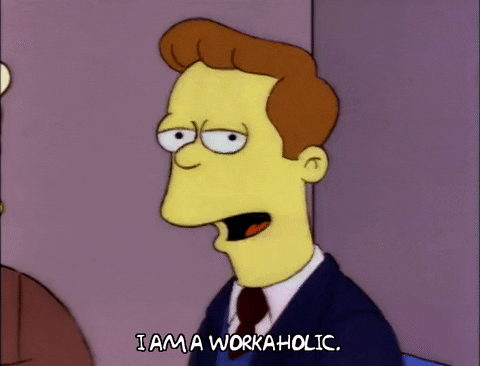When I started my affiliate program back in 2005, I didn’t realize it at that time, but I rode through my Perfect Storm. Fortunately, I survived and emerged with a $1 million a month affiliate program within 18 months, but…if I hadn’t made all those mistakes… I might have hit $2 million a month! And I made some real doozies! This is GREAT news for you because I will share all of them with you here…so YOU don’t have to make them!
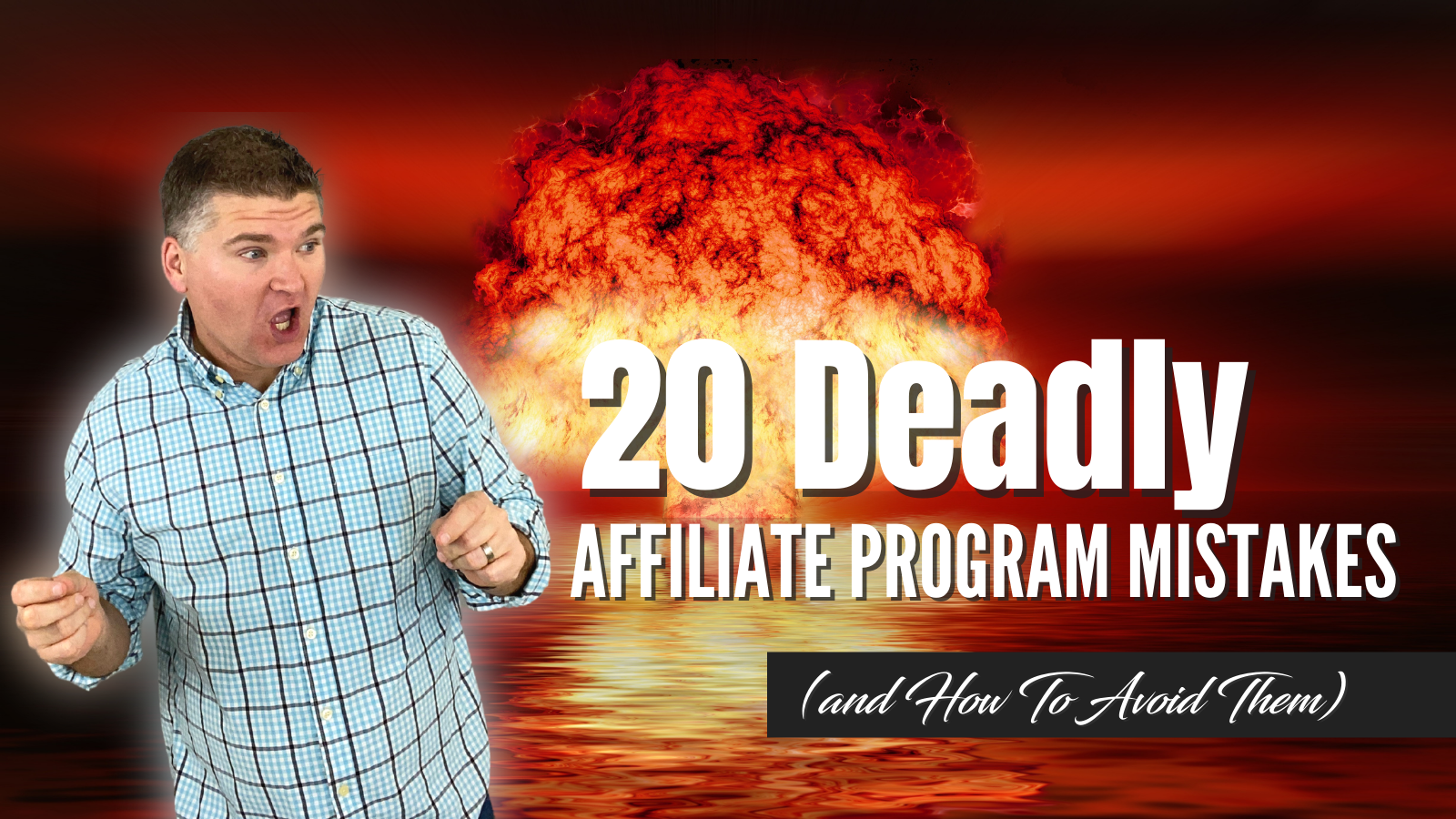
Back then, I had no idea what I was doing. The affiliate program niche was just in its beginning stages. So in a funny, kinda way, my timing was perfect. Today, I could NEVER get away with the mistakes I made then.
In this post, I’m going to drain my affiliate program “ocean” to reveal all the affiliate program mistakes I made so you easily avoid them and spend your time growing your affiliate program more efficiently.
Let’s get started…
Mistake #1: Waiting too long to start our affiliate program
Instead of building ourselves a little momentum, we waited until we were desperate. We NEEDED to start a business. When you put yourself in that position, the odds are stacked against you. The smart thing to do would have been to give ourselves a little wiggle room. For example, say you have a full-time job that brings in $60,000 a year and a side hustle that puts another $20,000 in your jeans. Maybe put that extra $20,000 aside for two or three years and THEN start your affiliate program.
We tried a bunch of other things first – rabbit hole stuff – instead of just starting our affiliate program. The problem was that there were no “how-not-to” instructions like the ones you’re getting in this post. There was no Affiliate Guy Podcast to help me. None of our competitors had an affiliate program back in 2005. We were blazing the affiliate program trail.
Like many success stories, there was a spark that got us off the launchpad. His name was Fred. (not his real name cuz he’s well known) Fred has been on the TED stage. Not training wheel “X” stage. The Real Deal. He’s probably got four or five bestselling books under his belt. Huge email list. He’s doing at least $6 million a year. Likely closer to $8 million. He and I met about four years ago and one day, I casually mentioned that he could really ramp things up if he implemented an affiliate program.
His response:
I don’t need an affiliate program.
I’m running Facebook ads and we’re killing it!
At that point, about 80% to 90% of his revenue was coming from Facebook ads.
Now the irony is, this guy built his business empire mostly by telling people to diversify their incomes through a number of different investment channels. And then he committed a classic mistake: He was putting ALL of his marketing eggs into the Facebook basket. Fast forward four months later…
Facebook shut his account down!
Not because he was doing anything wrong. It’s just something that randomly happens from time to time.
IMPORTANT TIP: You should make sure you have a second Facebook ad account ready to go just in case. That way, you have a backup.
Anyway, back to our boy Fred.
It took his people about a week to get the ads account back up and running. The cost?
A full week of dealing with Facebook to sort things out PLUS:
- Nearly no revenue
- No leads coming in
- His entire business virtually shut down
- His cost-per-click rates doubled
- Their ad costs soared
- A significant financial impact on their incoming revenue
= DISASTER!
Fred’s decision to delay starting an affiliate program resulted in his company going from $500,000 a month to less than $250,000. And their ad cost went up almost 60%. I got the call from Fred a few days later.
Unfortunately for him, I had doubled my rates by then. Here’s the lesson: Don’t underestimate the benefits of an affiliate program. Those big platforms like Facebook, Google, LinkedIn, and TikTok are huge. But when stuff happens, it usually happens BIG! The longer you go without an affiliate program, the longer you are putting a very low ceiling on your growth.
Scalability, easy targeting, warm prospects, and no risk because you make money before you spend it – they’re all there at your fingertips with an affiliate program. We waited way too long to start. Once we did actually start reaching out to build our affiliate program, we made our second mistake!
Mistake #2: Our introduction emails were too lengthy
When I say “our,” I mean “my.” The two business partners I had at the time tried to warn me. But in my efforts to find affiliates and recruit them, I had my own ideas. The first email message was too lengthy. When I think back, it’s amazing that these 6-10 paragraph eye glazers got anyone’s attention. I packed them with stats on conversion rates. Earnings per click. Links galore to our various landing pages. Our LinkedIn page. Blah. Blah. Blah.
Hello? I didn’t know these people. I didn’t even know anybody in the industry. And I’m reaching out to them cold with an email that would read like some user agreement??!! Oh and by the way, ‘would you like to be part of our affiliate program”?
But here’s the thing: it sort of worked! Mainly because I was likely the first person who ever reached out to them about being an affiliate for the insurance leads program. They weren’t getting very many emails about that. So I got away with it…THEN. Today? No chance! The key now is to keep your initial contact short. Super short.
Your goal is not to get a yes response. Huh? I know. Sounds weird, right? But in the early going, your objective is simply to pique curiosity. What you’re trying to do is inspire them to say the following:
“TELL. ME. MORE.”
Once they give you permission to talk about your product, you’re on your way. Forget the long-winded approach with your initial contact. Stay short!
VALUABLE RESOURCE: Here’s a link to my #1 affiliate recruiting email that will help you get that “tell me more” response. We’ve been refining it over the last 15 years. It’s super short and extremely effective. Get it here.
Mistake #3: Thinking I needed to know all of our affiliates
You hear it ALL the time. A successful business is about building relationships. Right? When I started out, I thought building relationships meant I had to know all of my affiliates which made my initial objective of bringing on hundreds of affiliates seem impossible. I’m thinking… how many affiliates could you actually develop relationships with? 20? 30?
Well, because I didn’t know any better, I was unnecessarily creating a big mountain of frustration.
I began to question my plan to attract hundreds of affiliates and resigned myself to thinking I would have to try and attract only big affiliates. After all, if I had to become best friends with every single one of our affiliates, how could I possibly have small affiliates and reach my financial goals? Plus, I was starting from scratch. I didn’t know anyone! There was no dad with the right connections to get me going. No social circle where everyone knew me.
And yet in two years, we built a million-dollar-a-month affiliate program.
How’d we do it? If you’re guessing we rethought our affiliate recruitment strategy, you’re right. I’ll get to that in a minute but first, I want to share a live lesson we did recently where we revealed the biggest lie that you’ve been told about finding affiliates. In this lesson, you’ll meet Alex. He went from being a complete nobody on the affiliate playing field to an industry leader in only 9 months using the strategy I’m about to share with you.
After some coaching I did with Alex a awhile back, here’s what he said:
Matt, I just had to let you know this. When I signed up for the training, I didn’t know anyone who could be an affiliate. Yesterday, we finished our first launch of the course and did $374,000! $360,000 of that was from affiliates. I’m on bleeping cloud nine right now. Thank you! Thank you! Thank you!
Lots of exclamation points, right? In less than a year, he went from knowing no one in his niche to doing $360,000 in affiliate sales…and he didn’t know a soul before!
So, can you see yourself doing this? Like, could you see yourself reaching out to people you don’t even know and getting them to be affiliates? Of course, you can!
Now, here’s the thing… on this Facebook live…I reveal the company’s secret weapon we’ve been using for over 14 years. Once you learn what it is, you may be tempted to brush it off because it seems so obvious. So simple. Please don’t! It’s your ticket to affiliate program success! It took me a whole year to figure it out.
Bottom Line: You absolutely do not need to know all of your affiliates. We’ll revisit this in Mistake #6 but let’s move on to the next affiliate program mistake you want to avoid.
Mistake #4: Not investing enough in relationships early on
I did not work on building better relationships with existing and prospective affiliates. There, I said it! I was very transactional and had a great personality. I was good on the phone. Why did I need to work at strengthening and building relationships with people who might become affiliates?
After all, it might be a year or more before they finally agreed to promote. It took me about two years before I realized how much this mistake was costing me. Lesson learned: invest first and THEN seek out big affiliates. It’s very unlikely you’re going to go out and bag an industry leader in your niche to be an affiliate. That’s not going to happen.
Consider what Alex was able to accomplish: $360,000 in a single launch! What I found is when you’re first starting out, you need to make some money. That means attracting small and medium-size affiliates. You simply don’t have the luxury of being able to invest in the big dog relationships that might take 5 years to develop.
Here’s what worked for me…in the early days, I spent 70% of my time on getting new relationships. 20% was spent investing in the existing relationships. The remaining 10% was used to research looking for potential relationships. As my business grew and I became more experienced, that changed to 40% spent on finding new relationships, 40% on nurturing existing relationships, and 20% searching for new opportunities. As your affiliate program grows, the amount of time you spend trying to get new relationships will go down compared to the amount of time you spend on your current relationships.
And here’s the good news: it’s about 20 times easier in terms of time and effort to keep a relationship than it is to get a new one. All it takes is a text here. A congratulations email there. Just a consistent effort of little “touches”.
FREE RESOURCE: Search networking here on my site and you’ll get a ton of helpful “keep in touch” ideas. The key is to stay on the radar of prospects and clients.
Mistake #5: Not setting up the right cookie length
The next big mistake I made was simple – but costly. I didn’t set up the right cookie length. In the affiliate program world, a “digital” cookie identifies the length of time one of your affiliates will get credited after the initial click.
For example, let’s say you were one of my affiliates. And say I set the cookie length duration at 90 days. That means If someone clicks on your affiliate link sometime within the next 90 days, you get credit. If they buy on the 91st day, you don’t. That is a 90-day cookie. Knowing what I know now, my advice would be to set your cookie length for a lifetime. I’ll explain why in a second.
When we were starting out, we set our cookie length at 30 days. If someone purchased on Day 31, tough luck. No credit. There are two reasons that was a mistake. First, it lowered their commissions. Really motivating huh? Second, we looked cheap.
So why’d we do it? That’s what the default was for the affiliate program we set up! We didn’t know it at the time but we were setting ourselves up for failure.
We realized we needed to change to a lifetime cookie. And here’s why: we studied the numbers and discovered back then that less than 3% of our transactions happened outside of 30 days. Changing to a lifetime cookie was hardly going to cost us anything. And we could go around trumpeting the fact that we had a lifetime cookie which was a big competitive advantage at that time. Out of 10,000 affiliate programs across all these niches, we were one of a handful that offered a lifetime cookie.
And let’s be honest…these affiliates work their butts off to send you traffic and leads and then you’re going to be cheap out on them?
There are some other big advantages when you set up a lifetime cookie.
- It makes everything easier.
- You don’t have to explain it.
- It attracts additional affiliates you might not have gotten.
And there’s another benefit we discovered by accident. Let’s say an affiliate stopped promoting but makes a sale a year and a half later. He goes down to the mailbox one day and discovers a check for $800 from you out of the blue.
Here’s where the magic happens. Instead of simply sending the check, send them an email letting them know what it’s for. Blows them away! And it gives you a chance to re-engage because you just sent them money out of the blue. The timing’s perfect to slip in, ‘Hey, we have a promotion coming up. Interested? Chances are they will be since they just got some “found” money – courtesy of you.
When we have to pay our affiliates a little bit of a lifetime commission every now and again for something they didn’t do, I’m happy to make the investment. So make sure you just go with a lifetime cookie setup and make it easy – and profitable – for everyone.
Mistake #6: Not working with smaller affiliates
Don’t do what I did when I started recruiting affiliates. My initial strategy/mindset was, ‘I’m not going to work with some guy who’s going to make like one sale a month.’ My thinking was we need to get off to a flying start so let’s track down big affiliates and bring them on. We need to make a big splash. Guess what? The bigger affiliates didn’t share our thinking.
First of all, you’re probably not going to get the big ones when you’re starting out. The key is to bring on small affiliates – ones slightly at your peer level or just above or below it.
Here’s a video you can check out on “10 Reasons Why You Should Work With Small Affiliates.”
Ultimately, it’s a numbers game. If you bring on 100 affiliates from a small list of 700, they’re going to make you about one sale – give or take – every four months. So, about three a year from a launch. They’re going to send you about 29 opt-ins from your first PLC. Maybe 37 registrations for your evergreen webinar. In other words, they’re not going to grow your list all that much. You might be tempted to think it doesn’t seem worth it.
Fast forward to four years from now.
Let’s say of those 100, 30 got out of the game. Quit. Gone. So they didn’t grow. BUT…30 others are going to be twice as big as they were. That list of 700 they started with? Now it’s at 1,400. So they’re going to make a sale every 40 days now. When you do the math, that’s not bad. Not game-changing but…when you have a launch, they’re gonna make two or three sales. They’re going to send you 87 registrations for the webinar – almost two and a half times more than when they started.
And remember, that they’re going to promote everything. That’s one big advantage with them. They’re going to grow steadily. They’re going to get their own partners. Five of them will literally grow by 10 to 25 times. Some will hit 100x. They’re going to hit it big. They turned a small list into 50,000 email subscribers. Their podcast takes off.
Now, even if this happens with only two, three, or four of those original hundred, they will be loyal forever. They will remember that you worked with them when they were a nobody. I have affiliates to this day that promote my products in a completely different niche. Two in particular that I can think of that I’ve worked with since 2007 are massively large today. And they are incredibly loyal to me.
So I’m going to repeat: do not make the mistake of ignoring small affiliates.
Here’s another little bonus: Small affiliates give you a testing ground. You want to make mistakes with small affiliates. You are going to want to try different strategies right, as you build your dream? When you work with small affiliates, you learn things.
Mistake #7: Being cheap with our commissions
In the beginning, I tried to nickel and dime my affiliates. Part of that was we kind of needed the nickel and the dime but looking back it was brutal. I remember wondering if we could get away with only paying 50%. To me, that put us on a par with everyone else.
And then it hit me! We don’t want to be like everyone else. We’re the new kid on the block. The solution? Offer an unheard-of commission! So starting February of 2005, we started paying our top affiliates 70%. We promoted 60% which gave us room to go to 70%.
I got a bit TOO generous. Don’t offer everything. Sure, give yourself some wiggle room to give a super affiliate a little bump. Put yourself in a position to be able to say to an affiliate, “Hey, if you send us 10,000 in sales this month, I’m going to bump you up to this commission level.”
Here’s a video I did that will help you negotiate commissions with your affiliates.
You want to avoid paying too much to the point where you literally don’t make any money. You also don’t want to pay too much too early on. When you do that, you paint yourself into a corner with no room to raise it. If I had to do it again, I’d start at 50% with a bump to 60%. We did have some affiliates where we offered 80%. They were interested in working with us and were big enough that, even at that rate, they brought in a lot of money. Any way you look at it, a good commission is one of the best investments you can make.
So watch the video. You definitely want to set up your commission structure the right way.
Mistake #8: Not analyzing affiliate data.
In the beginning, I kept a close watch on my affiliate activity.

But as our company grew and we started getting busy, I started to drift away from monitoring our affiliates. Sales had ramped up to about $100K a month and I had all these other responsibilities calling for my attention. We started bringing on a team and before I knew it, I’d find myself in meetings for half the day. So I stopped analyzing the affiliate data.
The ridiculous thing is it only has to take 5 minutes a day! And those 5 minutes can play a critical role in helping you get some important insight into what’s happening. You can spot trends like who’s falling off and who’s suddenly making more sales.
FULL DISCLOSURE: This isn’t my strength. I hired it out so that I could get a report every day that I could scan in a couple of minutes.
You can set it up so you can spot trends day to day, week to week, and month to month. If you have an evergreen program or you’re in a launch, you can see at a glance what’s going on. If someone’s falling off OR killin’ it, you want to reach out to them. Who’s up, who’s down? Who’s got really low conversions or who’s got really high conversions? Who made their first sale? Who hit some other milestone?
By the way, as you do become aware of various milestones, you have a great opportunity for ETMs – excuses to mail. Any opportunity we have to reach out to an affiliate, the better. And all it takes is a few minutes per day. Keeping an eye on your data will allow you to be proactive and stay in control.
Mistake #9: Straying from the basics
As we got bigger, we started getting more elaborate with our promotions like sending like these glossy mailings and things like that. These can be great. But we got away from the basics – the stuff we knew was proven to work. One of the business philosophies that has served me very well is: STICK WITH WHAT’S WORKING!
There’s nothing wrong with trying new approaches and strategies but don’t let them take you away from the stuff that works. Continue reaching out to new affiliates. Keep sending out short messages. Don’t forget about investing in relationships early on or building better relationships with your current affiliates. Even things like offering a lifetime cookie.
These basics are the “oil” that keeps your business running smoothly. Find what’s working and keep doing more of it.
Mistake #10: Not inviting our customers to be affiliates
This mistake cost us millions of dollars in the first year. What better source could you find for your promotional partners than your existing customers? Answer: There isn’t one. Oddly enough, so many marketers completely ignore this goldmine.
I talk about it in this post, where I share 3 surprising sources of affiliate partners.
We made this mistake in 2005. But I continue to see people making it today. Think about it. Your customers have an intimate knowledge of your product or your service. They know your personal story. They know, like, and trust you. They will defend you to others. You couldn’t ask for better promoters than your customers. And it’s so000000 easy to bring them on.
Especially if you are using a system like Infusionsoft which allows you to automatically sign them up as referral partners. You simply create an autoresponder campaign and send out an email asking, ‘Hey, do you want to become an affiliate? Do you want to promote?’ See if they want to share with their audience and make some money.
Depending upon your niche, you may or may not want to call them affiliates. In some niches, we actually don’t. Instead, we refer to them as partners or ambassadors. Many don’t even know what an affiliate is. And if you aren’t using a CRM like Infusionsoft, have an assistant go in and create links for your customers.
Mistake #11: Not getting out there
When I started, I wasn’t going to industry conferences where I could meet with affiliates and seek out new opportunities. In fact, I was downright elusive. And I almost wore that elusiveness like a badge of honor. It was like I became this mythical affiliate manager people communicated with via email, talked to on the phone, and been spotted on video but……meet face-to-face??? NEVER!

Over 10 years, I went to 3 conferences. And when I say “went” to them, I was almost invisible. I’d get there five minutes before it opened and I left when it closed. The whole time I was there? I did my thing. No hanging out with anyone. Just wasn’t my thing.
So much so that even in 2010, when I won my first Affiliate Manager of the Year award, I didn’t even go to the ceremony in person. I won a couple of times over the next few years and I found out because someone who attended the awards texted me. I wasn’t on social media. And I rarely interacted with our affiliates outside of a professional setting.
My relationships were more transaction-based. I hardly knew any of my affiliates. Whether they had families. What was going on in their lives? Nothing. Guess what? My relationships sucked.
Today, that’s all changed. Now I’m constantly interacting with our top affiliates and prospects. Obviously, because of the COVID-19 pandemic, the in-person conference events are limited but there are plenty of “virtual” events where you can participate in the chat and explore new relationships. You know, I make it a point when I go to a virtual conference to be seen in the chat. I realize now how important interaction is.
Here’s an example:
One of our top affiliates is a Kansas City Chiefs fan. When they won the Super Bowl this year, I reached out to him to congratulate him. He REALLY appreciated it.
If you know where one of your clients went to college and their team wins a championship, reach out and congratulate them. When a natural disaster hits in their area, reach out to see if they’re okay. Don’t be invisible.
Mistake #12: Delegating our affiliate communication
Once our affiliate program grew to about 200 affiliates, I got really busy. As the Chief Operating Officer, I ran our quality control department and I was also responsible for a few of our bigger accounts – mostly because I had these responsibilities since we started the company. Those two things alone took up 4-5 hours a day. I was working 12 hours a day 6 days a week. Good thing I was single at the time but I had no life outside of work.
I only had about five or six hours left over each day to do anything that involved affiliates. Throw in a few leadership meetings along with shaping the strategy of the company and it became obvious that I had to delegate a lot of my responsibilities as the affiliate manager.
One of the things I handed off was communication with the affiliates.
It was one of the biggest mistakes I made.
There are lots of things you can – and should – delegate.
- Reviewing stats.
- Creating reports.
- Creating swipe copy.
- Creating graphics.
- Setting up the affiliate portal.
- Sending affiliate links.
You can even delegate some of the affiliate training, but you should never delegate important communication. When you take the time to build affiliate relationships, they need to hear from YOU. Whether it’s an email, a text, or a Facebook message. It’s important they get personal communication. We’ll get five, sometimes 10 times the results when I send a message to our affiliates as we do when the same message is sent by an assistant or someone else on our team.
Here’s a simple way to make communication a priority and it will only take you about 30 minutes a week to do it. Try spending about 30 minutes a day, five days a week on affiliate-related activity. That’s two and a half hours a week. You don’t have to do more than that. For me, this system works great. I like to go for walks when I’m on call so I can easily do a couple of those early in the week. I might spend the daily 30-minute session just sending out emails. Another might be replying to emails. The fifth day can be a bit of a hodgepodge. I might send a few texts. Reply to a few emails. I’ll shoot a couple of Facebook messages. I’ll just go engage on social media with them.
Here’s my golden rule: I prioritize communication with current affiliates.
So, for 30 minutes a day, every weekday, just try reaching out and engaging with your affiliates and then one hour a week on mass communication. If you do three and a half hours a week, I promise you will run a successful affiliate program.
Mistake #13: Not consistently bringing on new affiliates
When we first started, I KNEW that sitting in the office all day when we didn’t have any money wasn’t a good idea. So what did I do? I spent five or six hours a day recruiting, It consumed me. I still had those other responsibilities but those went on the back burner. I’d fit them in when I could.
My laser focus was on researching affiliates and reaching out to them. Even when we had like 30 affiliates, I’d still spend 90% of my time finding new affiliates. When we got to 50 affiliates, it became 80%. When we hit a hundred, the time I spent working on bringing on new affiliates decreased to 70%. Once we hit 200, my recruiting activity came to a virtual halt.
I started going months at a time without recruiting an affiliate. Not just a quarter would go by. I’m talking 5 to 6 months!
I wasn’t bringing in ANY new affiliates. And this was bringing our affiliate program growth to a halt.

And that’s one of the common growing pains with affiliate programs. You reach a point where managing your current affiliates just takes up so much of your time. When you have other responsibilities, it feels like you have no time to recruit affiliates – Which is why I would go months without recruiting new affiliates.
Here’s the solution: ABR.
Always.
Be.
Recruiting.
There’s a concept called the “20-mile March”. The idea is to do a specified amount of activity each day. Watch Jim Collins do a much more eloquent job of explaining it than me in this video.
You can apply this concept to your affiliate recruiting activities. Just commit 20 minutes every single day to finding new affiliates. Put it on your calendar as an appointment. This key is 20 minutes a day. I still remember the time for my “20-mile March.”
Every Monday through Friday at 8:35 AM. We had a leadership meeting at 9:00 AM. I would usually get to the office a little after 8, walk around, talk to people, just interact with our team. Then, I would sit down at 8:35 and work on recruiting activities. And I’d do it in 20 minutes. I would literally set a timer to go off at 8:55. And I rarely missed a day. Occasionally I’d have something I had to doo but for the most part – every day, 8:35 AM, for 20 minutes, I’d recruit affiliates. And I’d usually be able to reach out to three new affiliates on average. That’s it.
That exercise was one of the things that helped us grow. 20 minutes a day. You can do it!
Mistake #14: Removing “inactive” affiliates
When our revenues got up around the $600,000 – $700,000 per month level, I came up with a really, really, really bad idea. I removed inactive affiliates. Don’t do that. Here’s why: just because they don’t promote you for a while – even if it’s a year – doesn’t mean they never will. We’ve seen examples where affiliates have been completely inactive and then suddenly just sprouted up out of nowhere.
Here are some of my top strategies on how to activate your inactive affiliates. That post will walk you through some of the reactivation ideas that work really well.
Most of the time the reason an affiliate becomes inactive is that they just got busy, This is very common – especially during launches. Could be its other work. Doing stuff with their kids. Maybe they got sick. In short, life may have gotten in the way. Often, all they need is a gentle reminder. Remember, on most days, they have a ton of emails to plow through. Calls to return. Posts to write. Videos and podcasts to record.
You are not their #1 priority.
A subtle reminder can quickly get them fired up again. One strategy we’ve used successfully is running re-activation campaigns. Now, do you want to reactivate EVERYBODY? No. We’re not looking for people who are sending just a couple of clicks a month. That’s probably because they have small lists. They have a tiny blog that gets barely any visitors. That’s fine. We’ve literally tested more than 300 of these over the years. Get all of my best affiliate activation templates here.
So what about evergreen programs? Say you have an evergreen program and some affiliates have become inactive. Why does that happen? Why would somebody be inactive?
Reason #1 They just signed up on an impulse. This happens a lot. They see someone else promoting something so they sign up and then realize it’s not a good fit for their audience. When this happens, there’s not much you can do. If you discover this has happened just remove them and move on.
Reason #2 They decide to promote another company. It happens. No matter how awesome your product is, how great the commissions are…sometimes, people are going to go promote something else.
Reason #3 They might’ve gone out of business.
Reason #4 They don’t know how to promote. Your job is to help them succeed.
Reason #5 They’re going to get around to it later.
Usually, all it takes is a gentle reminder. So give them that nudge. Try using some of these email activation templates.
Mistake #15: Not creating individual affiliate plans
I wrote an entire article about getting affiliates to go all-in. In this article, I share seven ways to make sure that your affiliates go ALL IN so that they commit to promoting you. Not creating these individual affiliate plans really kept us from growing. It was a huge mistake.
Mistake #16: Not giving affiliates specific promotional strategies
Now, this mistake is related to the last one. We used to offer a one-size-fits-all all promotional strategy. That’s NOT the way to do it. You got to keep in mind, every affiliate has their own stuff going on. They have their own calendar. Just because you’re releasing Video 1 on Tuesday doesn’t mean they’re going to mail about it on Tuesday. You must get creative.
For example, is there a way for them to mail it out on Monday to give their audience early access? When they can’t mail on Tuesday or Wednesday, what can you do for them? Maybe offer them an exclusive coupon? Or an exclusive bonus or access? How about exclusive messaging? Is there something that you can offer that’s specific to them?
Now, can you do this for all your affiliates? Of course not. Can you do it for your top 10 or 20 or 30? The answer is likely yes. Be flexible and creative when they come to you and say, “Hey Matt, my audience is such and such…can you create and customize something for them? Help them with some messaging.
The cool thing is that this will allow you to expand and get other affiliates who have similar needs.
Mistake #17: Not having enough entry points
This is a mistake that I made with some early affiliate programs. We had programs with pre-launch content that consisted of three videos, a webinar, and a sales page – 5 entry points…
We did a study a while back and we looked at the data points on launches that were $5 million to $10 million versus launches that were $12 million to $17 million. We purposely left out those ones in the middle because we wanted there to be a little bit of a gap. So what did we discover? (By the way, don’t get caught up in the numbers. The same principles apply for a $1M – $4M launch.)
The higher return came from webinar registration pages that were more optimized with ways to get onboard. They used multiple ways to get people to show up to webinars. Determining the number of entry points is something you can control.
Eight-figure launches had 75% more entry points than seven-figure launches.
So aside from conversion rates, a number of affiliates (especially for bigger programs), commissions, contests, and the like, it boiled down to the number of entry points.
Instead of three videos, a webinar, and a sales page, use three videos, three PDFs, and two different webinars for two different audiences. You can add in a quiz and an assessment. Maybe another free report. Lesson Learned: 12 – 13 entry points are going to get better results than 5. You want to offer your affiliates as many ATMs (excuses to mail) and ETPs (excuses to promote) as possible. When you only give them three, they’ll do three. When you give them seven, they’ll do seven. Give them 11 and they’ll use a good portion of them.
The more you offer, the more chance they have to pick which ones are going to work best for them.
Mistake #18: Not policing our affiliates
I’ve probably worked with over 300,000 affiliates. From time to time, you come across bad actors. I’ve run into 50 bad ones where they were doing something to hurt our brand. It was usually illegal or immoral. It’s not something that happens a lot but I think it’s fair to say you will likely encounter it at some point.
That’s why you want to monitor affiliate behavior. Make sure your affiliates are compliant. Make sure that they’re following the FTC guidelines. Make sure they’re disclosing that they are doing so. We got away from making sure affiliates weren’t doing anything unethical or illegal and it got us in trouble. In one instance, I was sued by the FTC. It didn’t amount to anything because I wasn’t doing anything wrong but it was a bit unnerving and sucked up time we could have used in more productive ways.
So, spend 5-10 minutes a week policing your affiliates and keeping track of their behavior.
Mistake #19: Not providing the right creative material
You cannot just give affiliates a bit of swipe copy and think that’s going to get the job done. Email is very important. So you want like check out my guide to creating great email swipe copy.
You also want to make sure they have:
- Text links.
- Banners.
- Social media creatives for all the major channels (which are constantly changing.)
- Coupon creators.
- Headshots. Action shots. (for the product creator)
- Videos.
Give your affiliates LOTS of options so they have what they need.
I love it when it takes me an extra three minutes to find something because they gave me 37 options!
Mistake #20: Not communicating with our affiliates between launches
Now, this is only relevant if you have an occasional launch or a big program, but if you have an evergreen program or you do a big discount or bonus every quarter or are doing “something” every 90 days, you’re already keeping everyone involved. But if you only have a once or twice-a-year launch, what do you do in between to stay connected with your affiliates? 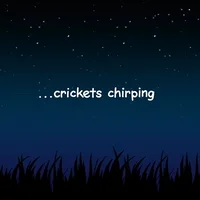
We used to go dark. Complete radar silence. We wouldn’t communicate at all, And then we’d come out of the woodwork four months later all rah-rah and be like ‘Hey, you’re going to promote us again?’ The results were predictable. ‘No, I’ve moved on….’ and we’d lose them. So make sure you stay in touch.
One of the most effective ways to do that is to send them something every couple of weeks. Maybe an update. Or commissions. And, if you send them a commission check, make sure you include a note that says something like, “Hey just a reminder…our next upcoming production is in 90 days.” It doesn’t take much to fire off an email every few weeks letting them know about a new post in the affiliates group or on Facebook.
It might look something like this:
Say you do a once-a-year launch that lasts two weeks. You’re going to warm them up 4 weeks before that. So, that takes care of 6 weeks. What do you do the other 46 weeks of the year? Here’s what I recommend: About two weeks after the launch ends, you post and share some testimonials. Then, 4 weeks after that, share the amazing results people are getting. That leaves you with 40 weeks to stay in touch. Do this: about every eight weeks – so 5 times during those 40 weeks – you could send an email post in the Facebook group, sharing a story from people who are using the product and have gone through the course.
That’s a great way to stay connected with your affiliates so they’re ready to roll when your next promotion hits. Keep reminding them of the dates of your next launch. Take them behind the scenes as you prepare. 
Let them “see” what you’re doing as you prepare. Stuff like recording the course. Give them early access to the affiliate portal. Keep them engaged. These are all meaningful ways things you can keep in touch with them during the year.
So there you go…all 20 mistakes of the mistakes I feel like we’ve made.
These are the big ones… we probably made a bunch more.
Use the knowledge above to avoid these mistakes with YOUR affiliate program.
Questions?
Text me anytime at (260) 217-4619.
Or…check out some of my free reports to help you get on the right track:
 |
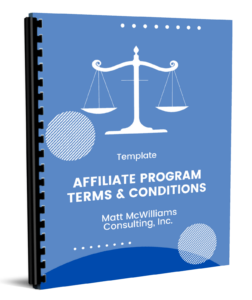 |
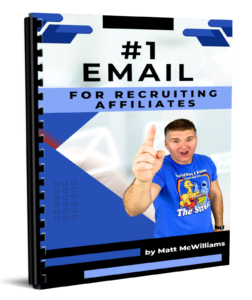 |
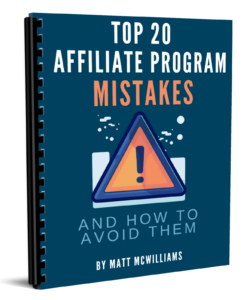 |
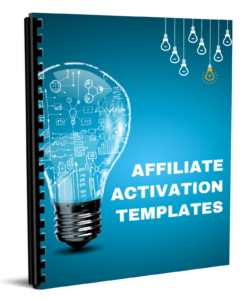 |
 |
 |
 |
 |


